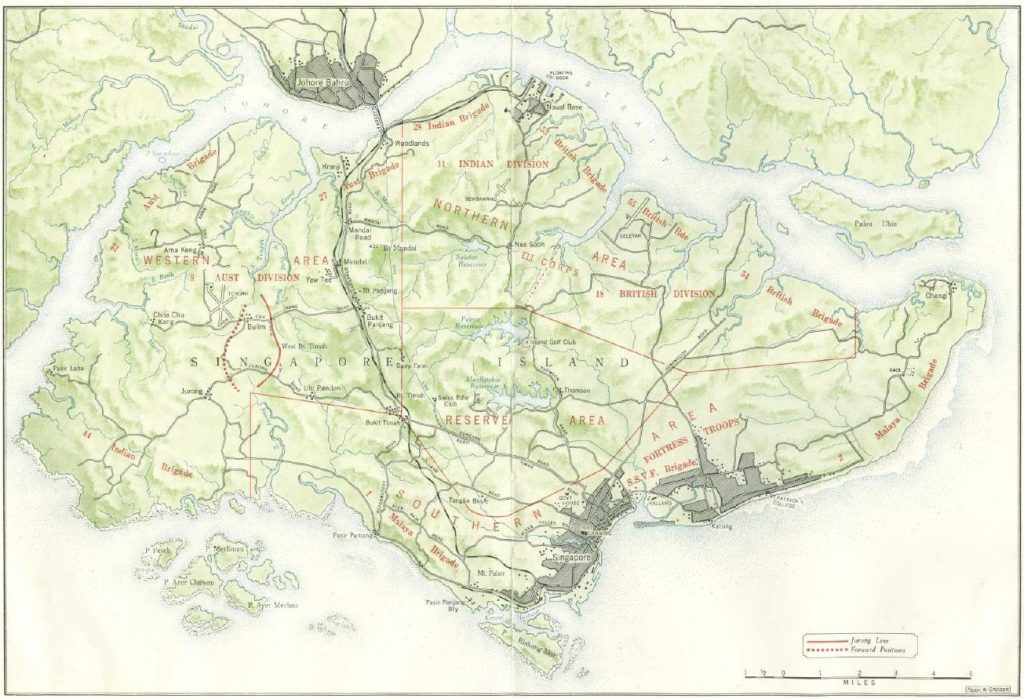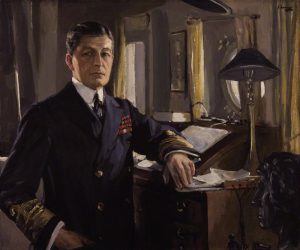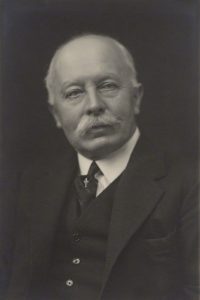Finest Hour 180
“Winston Has Gone Mad”: Churchill, the British Admiralty, and the Rise of Japanese Naval Power

Singapore Island
September 5, 2018
Finest Hour 180, Spring 2018
Page 23
By John H. Maurer
John Maurer is the Alfred Thayer Mahan Professor of Sea Power and Grand Strategy in the Strategy and Policy Department at the Naval War College. An earlier version of this article first appeared in The Journal of Strategic Studies.
In the aftermath of the First World War, Great Britain faced a serious strategic challenge in imperial Japan, whose nascent sea power threatened the security and interests of the British Empire in Asia. At the center of British decision making about Japan’s naval challenge in 1924–29 was Chancellor of the Exchequer Winston Churchill, who reviewed spending requests of government departments, set priorities, sought revenue, prepared budgets, and managed the economy in the hurly-burly politics of the public arena.
Churchill had just turned fifty and, at the height of his powers when he became Chancellor, was determined to take an active role in directing Britain’s grand strategy. One colleague described Churchill as “the most forceful personality in the Cabinet.”1 But he forcefully challenged the idea of conflict with Japan. In an oft-quoted letter to Prime Minister Stanley Baldwin, Churchill wrote: “why should there be a war with Japan? I do not believe there is the slightest chance of it in our lifetime.”2 Instead, he foresaw a “long peace, such as follows in the wake of great wars.”3 In a tragic irony of history, Churchill’s words would later come back to haunt him when Japan attacked the British Empire in December 1941.
Economizing Chancellor
Churchill’s views put him at odds with the Royal Navy, whose leaders urged a buildup of naval power against what they saw as a looming menace in Asia. Japan’s new generation of powerfully armed cruisers especially alarmed British naval planners. The Royal Navy wanted new cruisers of its own, as well as enhanced oil fuel supplies and naval bases in the Pacific.

2025 International Churchill Conference
The navy’s demands came at an inopportune time, when Britain was confronting harsh economic realities. The economy suffered from anemic growth and high unemployment. Churchill hoped to arrest this trend, and so improve his own political fortunes. His attempt to restrain defense spending brought him into a bruising, drawn-out, interdepartmental struggle with the navy. The politician and historian Roy Jenkins viewed this struggle as the “most dangerous of the disputes” that confronted him as Chancellor.4

Top naval leaders, fired up by the forceful First Sea Lord, Admiral Earl Beatty, threatened resignation en masse to protest against proposed cuts in warship construction. After one encounter with Churchill, with whom he had usually cordial relations, an exasperated Beatty complained: “That extraordinary fellow Winston has gone mad, economically mad, and no sacrifice is too great to achieve what in his short-sightedness is the panacea for all evils, to take 1/- [one shilling] off the Income Tax. Nobody outside a lunatic asylum expects a shilling off the Income Tax this Budget.”5
Wrong but Right
Clearly, Japan’s rising naval challenge posed awkward political, economic, and strategic tradeoffs. That as sagacious a statesman as Churchill misjudged the danger of war with Japan, believing that Japanese leaders would act as responsible stakeholders on the international stage, highlights the pitfalls that can bedevil even the very best strategic assessments. Churchill erred in his forecast that Japan’s rulers would show restraint in their foreign policy. He was, however, wrong for the right reasons.
Churchill’s argument to Baldwin was that “Japan is on the other end of the world. She cannot menace our vital security.”6 He did not deny that Japan would be a dangerous adversary—he argued only that Japanese forces were in no position to deliver a knockout blow against the heart and center of the British Empire.
“The only war it would be worth our while to fight with Japan,” Churchill continued, “would be to prevent an invasion of Australia.”7 That, he insisted, would require mounting a major naval and military effort at great distance from the British home islands, entailing enormous problems of supply and colossal costs and risks. Surely, Churchill argued, leaders on both sides would recoil from the prospect of so hideous a struggle. Even supposing a Japanese strike to destroy the British Empire in Asia, Churchill believed, the United States “would be thrown increasingly to our side.”8
While Japan would not embark on a war of its own, Churchill’s understanding of the international strategic environment did lead him to imagine a predatory Japan attacking the British Empire if Britain were endangered by some other great power, such as a revanchist Germany or an expansionist Soviet Union. This scenario, too, proved an accurate forecast: Japan’s rulers felt confident enough to attack Britain only in 1941, when it appeared that Germany was on the verge of scoring a major military success in Europe.
The principal Japanese threat, Churchill concluded, would occur if Britain were tied down elsewhere, fighting on several widely scattered fronts. In that case, he believed, salvation would depend on finding a coalition partner in the United States. This was not a new thought. In 1912, as First Lord of the Admiralty, Churchill had written: “If the power of Great Britain were shattered upon the sea, the only course open to the 5,000,000 of white men in the Pacific [that is, Australia and New Zealand] would be to seek the protection of the United States.”9 He clung to this view after the First World War as well: “Canada, Australia and New Zealand had very strong racial objections to the Japanese and would be disposed to throw in their lot with the United States against Japan in certain contingencies, as they already regarded the United States fleet in the Pacific in the light of a safeguard to themselves.”10 His strategic assessment demonstrated a deep understanding of the workings of the international balance of power and the importance of the United States in upholding that balance.
The Naval View

Britain’s naval leaders were sanguine neither about Japan’s future behavior nor about the chances of a permanent peace. First Lord of the Admiralty Sir William Bridgeman wrote: “No one can foretell the date of the next war.”11 Bridgeman had no difficulty imagining Japan striking out on the road of conquest. The First Lord contested the view held by Churchill and Britain’s top diplomats: “It has been said there is no danger of war— the common cry of the foolish virgins. Would the Foreign Office still say, in view of the racial unrest in the East that an anti-European wave of fanaticism might not seize the Japanese, bring about a revolution and the installment of a militarist Government?”12
One astute British naval officer, with considerable experience of service in Asia, maintained, “the Japanese Government and their people are entering a very critical period.” A struggle was “in full swing” between a “section of the ruling classes” who favor cooperation with the West and the “military party, who have hitherto dominated Japan’s policy, [and] do not take kindly to these new ideas which, as a very minimum, presuppose the subordination of armies and navies to civilian direction.” The outcome of this struggle within Japan was in doubt because “the majority of the Japanese nation have been brought up very stiffly upon extreme nationalist lines.”13 The militarists, intent upon whipping up and exploiting nationalist sentiments, could emerge the winners in Japan’s internal power struggle, thereby increasing the likelihood of conflict in East Asia. Bridgeman thought that Churchill’s assessment of Japan “ignores history, real facts and the psychology of the people.”14
Japanese external behavior might give the appearance of a responsible stakeholder invested in the international status quo, the Admiralty argued, but that could change. Increased trade and economic interdependence with other countries might expand not limit Japanese foreign ambitions. The veneer of liberalism—popular elections, political parties, cabinet government, international cooperation, arms control, and spending cuts imposed on armaments—hid what was actually a militaristic country bent on expansion. Japan’s growing economy was underwriting a naval buildup. Simple prudence dictated that Britain adopt a hedging strategy, undertaking substantial defense preparations to provide for a war against Japan even if that contingency appeared remote. The challenge was to balance financial reality with strategic possibility.
Churchill’s View
Churchill was a realist: he understood and did not deny the strategic risks that Britain was running by not funding all of the Royal Navy’s programs for warships, bases, and readiness. As a result, he felt obliged to consider even what he thought was an unlikely scenario of war with Japan.
In a remarkable strategic appreciation, Churchill envisioned what a contest between Britain and Japan would entail. At first, Britain should “make arrangements to base a squadron of battle-cruisers, or a fast division of battleships, or if possible both, upon Singapore during the period of strained relations, or as soon as may be after War has begun.” This force, supported by cruisers, destroyers, submarines, aircraft, and coastal artillery batteries, should remain on the defensive, avoiding any engagement with superior Japanese forces. Such a force would “prove an effectual deterrent against a Japanese attack on Singapore.”18 If deterrence failed and the Japanese sent an overwhelming force to take Singapore, then British covering forces should “withdraw without being drawn into decisive action at an inferiority” into the Indian Ocean, awaiting reinforcements.19
Churchill declared that the loss of Singapore during the early stages of a conflict did not mean Japan would win the war. “Great as are the injuries which Japan, if she ‘ran amok,’ could inflict upon our trade in the Northern Pacific, lamentable as would be the initial insults which she might offer to the British flag, I submit that it is beyond the power of Japan, in any period which we might foresee, to take any action which would prevent the whole might of the British empire being eventually brought to bear upon her.”20 A defensive strategy early, trading space for time until it could build overwhelming offensive force, would enable Britain to win. Remain on the defensive, Churchill counseled: hold at Singapore if feasible, guard trade routes in the Indian Ocean, until “a preconceived programme of new construction” started at the outbreak of war provided Britain with naval superiority over Japan.
At the Admiralty when the First World War began, Churchill had put in motion a huge program of naval construction. Toward the end, as Minister of Munitions, he had presided over manufacture of weaponry for British and Allied forces.15 This experience gave him first-hand knowledge and understanding of the economic mobilization required to fight a war against another great power. He predicted this new construction would be complete within two years of the war’s outbreak. Reinforcements sent to Asia would eventually enable Britain to move from defensive to offensive operations.
The initial campaigns of a Japanese war might cause the British Empire “great annoyance and expense,” but Churchill believed that they “would not make any difference to the final result.” Once Britain mobilized its resources in the Pacific, he maintained, “in three or four years we could certainly sweep the Japanese from the seas and force them to make peace.”16 Still, Churchill feared that terminating the war might require “large armies…to go and attack Japan in her home waters.” That, he said, “would reduce us to bankruptcy.”17
Deep Understanding
Churchill’s appreciation was sound advice should Japan opportunistically strike when Britain was held down in a conflict with another great power. Churchill did not try to hide the risks. He bluntly contemplated a long, costly war and the likelihood of an ally in the United States. He predicted losses in the beginning, but victory in the end. His strategic appraisal proved an accurate forecast. The competing assessments produced by Churchill and the Admiralty are significant in the way they complemented each other and, taken together, offered a window for seeing into the future.
Churchill was wrong to credit Japan’s rulers with greater strategic acumen and concern for the wellbeing of their people than what they actually possessed. As conflict with Japan loomed in 1941, he even sought to give Tokyo strategic advice—a prescient warning to underscore the dangers of provoking Britain and the United States.21 The extremist vision held by Japan’s rulers to dominate Asia, their refusal to show self-restraint, and their decision to unleash the powerful Japanese navy combined to inflict shattering blows on forward-deployed American and British forces in the Pacific, confounded Churchill’s hopes. In December 1941, soon after Japan had attacked Britain and the United States, Churchill told a joint session of Congress that it was “difficult to reconcile Japanese action with prudence or even sanity.”22 In predicting that the Japanese bid for hegemony in Asia would ultimately fail, Churchill showed a deeper understanding of national interest and grand strategy than the warlords of imperial Japan.
Endnotes
1. Papers of Lord Robert Cecil, MSS 51079, ff. 164–65, British Library.
2. Martin Gilbert, ed., The Churchill Documents, volume 11, The Exchequer Years 1922–1929 (Hillsdale, MI: Hillsdale College Press, 2009), p. 307.
3. Ibid., p. 366.
4. Roy Jenkins, The Chancellors (London: Macmillan, 1998), p. 306.
5. Brian Ranft, ed., The Beatty Papers, vol. 2, 1916–1927 (Aldershot: Scholar Press for the Navy Records Society, 1993), p. 277.
6. Gilbert, p. 306.
7. Ibid.
8. Gilbert, pp. 443–44.
9. Randolph S. Churchill, ed., The Churchill Documents, volume 5, At the Admiralty 1911–1914 (Hillsdale, MI: Hillsdale College Press, 2007), pp. 1511–14.
10. Committee on Imperial Defence, 134th Meeting, 14 December 1920, CAB 2/3, National Archives, Kew.
11. Philip Williamson, ed., The Modernisation of Conservative Politics: The Diaries and Letters of William Bridgeman, 1904–1935 (London: Historians’ Press, 1988), p. 186.
12. Ibid., p. 186.
13. Stephen King-Hall, Western Civilization and the Far East (London: Methuen, 1924), pp. 297–311.
14. Memorandum by the First Lord of the Admiralty, “Political Outlook in the Far East,” 5 March 1925, CAB 24/172, National Archives, Kew.
15. Eugene Edward Beiriger, Churchill, Munitions and Mechanical Warfare: The Practice of Supply and Strategy (New York: Peter Lang, 1997), passim.
16. Gilbert, pp. 443–44.
17. Ibid., p. 306.
18. This memo shows that during the mid-1920s, Churchill had already envisioned what would become known as Force Z, the “decisive deterrent” sent to Singapore on the eve of war with Japan. Winston S. Churchill, The Grand Alliance (Boston: Houghton Mifflin, 1950), pp. 578–624.
19. Gilbert, pp. 451–52.
20. Gilbert, p. 384.
21. Churchill, Grand Alliance, pp. 189–90.
22. Robert Rhodes James, ed., Churchill Speaks, 1897–1963: Collected Speeches in Peace and War (New York: Barnes and Noble, 1980), pp. 784–85.
Subscribe
WANT MORE?
Get the Churchill Bulletin delivered to your inbox once a month.



